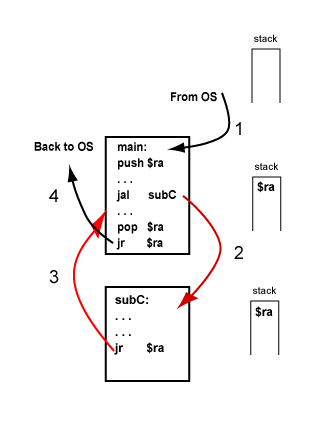Answer:
No.
No.

To
return to the caller
a subroutine must have the correct
return address
in $ra when
the jr instruction is performed.
But this address does not have to remain in $ra
all the time the subroutine is running.
It works fine
to save the value in $ra somewhere.
The value can be restored, later on, when
it is time to return to the caller.
In the picture,
the operating system calls
main.
The return address to the operating system
is in $ra.
As soon as it gets control,
main
pushes the return address on the stack main
should use when it returns to the operating system
is now on the top of the stack.
The "push" and "pop" instructions in the picture are conceptual. Actual code does these operations in the usual way.
After pushing the return address,
main computes for a bit,
and then calls subC
using a jal instruction (step 2).
This puts the return address to main
in $ra.
Luckily, it does not matter that $ra has
been changed because the return address that main
will use to return to the operating system is safely on the stack.
subC receives control and computes for a while.
Because it does not
call another subroutine, subC
does not alter $ra and does not need to save it on the stack.
When subC returns to main
it uses a jr $ra instruction (step 3).
Control returns to
main,
which computes for a while longer.
It returns to the OS
by popping the stack into $ra
and executing
a jr $ra instruction (step 4).
Exception handler service 10 is another way to return to the OS. For this example let us not do that.
Is there room on the stack for additional addresses?